|
|
|
Clark County Press, Neillsville, WI March 16, 1994, Page 32 Transcribed by Dolores (Mohr) Kenyon. Index of "Good Old Days" Articles
|
|
|
|
Clark County Press, Neillsville, WI March 16, 1994, Page 32 Transcribed by Dolores (Mohr) Kenyon. Index of "Good Old Days" Articles
|
Good Old Days
“Oldies”
By Dee Zimmerman
EARLY HISTORY OF HUMBIRD VILLAGE
Humbird is situated in the southwest portion of Clark County, its name taken from Jacob Humbird, the famous railroad builder. It was started in the year 1869, thriving quickly in its beginning.
In the fall and winter of 1873, a fearful malady struck the community, the infectious disease, smallpox, nearly destroyed all business and brought its growth to a standstill for that season.
Subsequently, the activity resumed and business once again flourished. The Sketch Book, published in 1875, stated, “To show how rapidly Western villages spring into existence, is a place known as Humbird and now occupied by graded streets, bordered by fine buildings, was in 1869, covered with heavy timber, where deer and other wild animals had a dwelling place.” Stumps from the large pines were visible throughout the village for several years after it was developed.
The village was situated with one of the largest pineries in the state on one side and rich newly developed farm land on its eastern side. Farm produce was hauled into Humbird and exchanged for lumber that was manufactured near the village. In addition to the lumber trade, mentioned, there were on the north and east, some extensive groves of pine timber, where there were several saw mills and shingle mills in operation. Materials from the outlying mills were shipped out of the Humbird railway station, a line of the West Wisconsin Railroad, and much of it was sent to Minnesota.
The area south and west consisting of fertile valleys, extending to the Mississippi River, produced an extensive grain and produce trade with Humbird as the shipping center for a full share of that. The grain, produce and lumber trade encouraged several branches of business to set up in the village with its promises for prosperity.
A large school building and a number of churches started along with the business development.
Among those who were leaders in the business enterprises was such as: George W. King, L. D. Holstead, S. Z. Smith (the renowned “ZENE”), Ben Webster, E. D. Carter, F. W. Whitcomb, and numerous others.
First business was the flour mill. The flour mill’s proprietor was William Schmidt who had a large expense in getting the power improved so as to insure its success. The extra ordinary length of the dam with its sandy foundation required the best in engineering and material with much courage on Schmidt’s part when he made the investment. The dam was an asset to the entire village and its residents.
The Humbird Business Directory read as follows:
Professional Men – O. G. Tripp, Attorney-at-Law, A. E. Holbrook, Physician, Russell Alderman, Physician, J. Q. A. Ball, Physician, Ira W. Wait, Physician, Prof. Wm. Van Waters, Teacher, Rev. Wm. L. Stanton, M. E. Pastor.
Merchants – E. G. Caarter, Dry Goods and Groceries; S. Z. Smith, Dealer in Grain, Hides, etc; H. C. Holbrook and Co, Drugs and Groceries; L. P. Holcomb, Dealer in horses and cattle; James McEhlors, Groceries and Provisions; Gilbert A. Tracey, Furniture; R. G. Shaw, hardware; Sidney, Houghton and Wilder, Dry Goods; Miss Mary A. Bone, Millinery.
Manufacturers – Wm. Schmidt, Flouring Mill; Henry Howes, Lumber Mfg.; Joseph Taft, Wagon Maker; Wm. Doty, harness maker; Mathias Haner, Brick Maker; Ernest Eilert, Brewery; G. W. King, Lumber Mfr.; Peter Zimmer, Boots and Shoes; Maurice Austin, Boots and Shoes.
Mechanics – Horace Stiles, Surveyor; Samuel Wise, Carpenter; Peter Wilson, Blacksmith; Albert Alderman, Carpenter; Simon P. Andrews, Mason; Henry Hartman, Blacksmith.
Miscellaneous – David B. Travis, Postmaster; Long and Wicker, Meat Market; Robert McEhlors, Photographer; Sylvester Macomber, Livery; F. W. Whitcomb, Railroad and express Agent; James Monell, Village Express; L. D. Holstead, Prop. The Holstead House; Albert Enason, Prop. the Humbird House.
Liquor Dealers – A. D. Soper, Francis and Danery, Peter Zimmer, Bowman and Hord, Geo. M. Andrews
The village of Humbird is a prime example of what many area villages started out as, serving the pioneering communities of which they were the center. The railroads also played an important role in each village’s existence, being the means of sending and receiving manufactured goods.
We are tomorrow’s past. – Mary Webb
¤¤¤¤¤¤¤¤¤¤¤¤¤¤¤¤¤¤¤
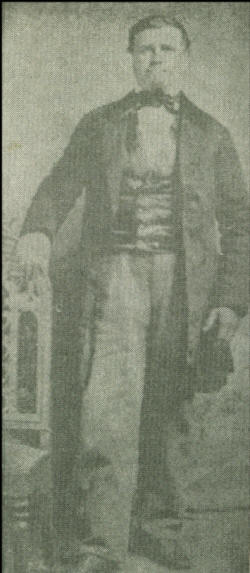 |
WILLIAM SCHMIDT Schmidt was one of the pioneer settlers of Clark County. In 1871, purposing to operate a grist mill, he made his own lake for power. He and he’s (his) helpers cut down the large pine trees and hewed out large timbers to make a dam. After the lake was formed, he built his grist mill and ground flour and feed on old-time mill stones.
The farmers came from far and near with their grist. Neillsville area farmers drove over one day and back the next. They had to bump over the rough corduroy road which connected Humbird and Neillsville, on what is now West 5th Street, or Highway 10, and Cty. Hwy. “B” was the corduroy road, same route.
Presently, Schmidt took a son-in-law into partnership. In later years, the son-in-law’s sons, Will and Oscar Hein, took over the mill business in Humbird. |
¤¤¤¤¤¤¤¤¤¤¤¤¤¤¤¤¤¤¤
|
J. W. PAGE, A SHERIFF OF CLARK COUNTY Page was a Clark County Sheriff in the 1890’s. Coming to the county at an early age, he was born in New Hampshire in 1865. He made his residence at Humbird, being engaged in lumbering until accepting the office of Sheriff in 1888.
|
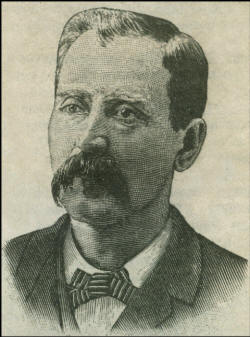 |
¤¤¤¤¤¤¤¤¤¤¤¤¤¤¤¤¤¤¤
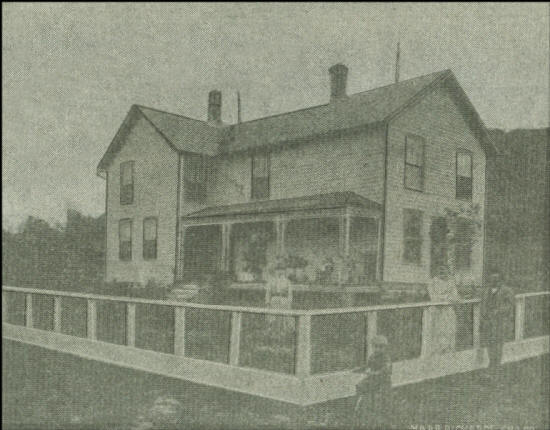 |
F. J. SIMMONS RESIDENCE
The Simons home was located near the center part of the Humbird village. Simons was a hardware merchant as of 1878. Born in Germany in 1850, he resided in Waukesha County, Elroy and Oconomowoc before coming to Humbird. He was also a tinner by trade.
¤¤¤¤¤¤¤¤¤¤¤¤¤¤¤¤¤¤¤
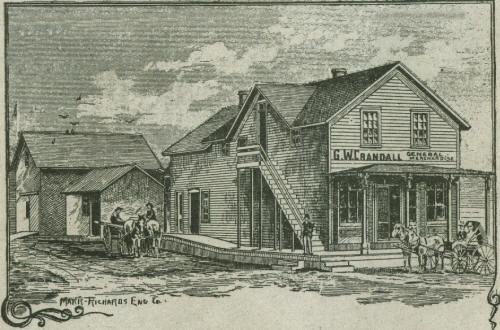 |
GENERAL STORE AND RESIDENCE OF GEORGE W. CRANDALL
The general store of Mr. Crandall was located in the village of Humbird, town of Mentor. Crandall, born in Canada in 1857, located in the town of Mentor as a farmer near the village of Humbird, then became a merchant in the village. He was married in 1876 to Miss Ida Albright, of Fond du Lac, Wis.
¤¤¤¤¤¤¤¤¤¤¤¤¤¤¤¤¤¤¤
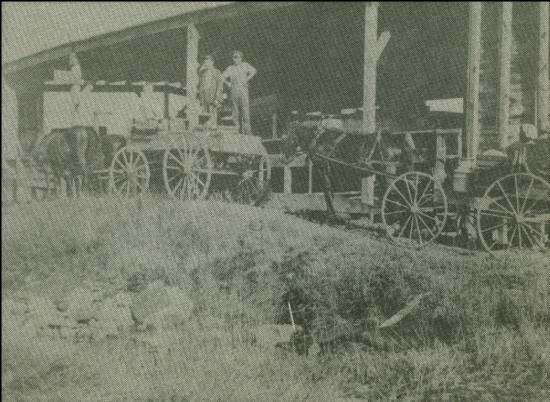 |
COLUMBIA PICKLE FACTORY
The Libby McNeill and Libby Co. of Chicago built and maintained a pickle factory in Columbia at about the turn of the century. A railroad spur had to be put in up to the factory, enabling a hook-up to the railway line. Schendlers donated the land and financed the right of way. Several Columbia area men helped prepare the rail bed and ties.
Acreage of 200 was required to put the pickle factory in operation for each season. Schendler and a Libby representative traveled many miles by horse and buggy, around the area, seeking farmers who would agree to planting and plowing cucumbers. Selling cucumbers to the pickling factory was a “cash crop” for the farm families.
It also provided seasonal employment for several men and was a busy place. The first manager was Louie Goebel of Michigan. Harry Hendricks and Leslie Sherman of Merrillan were also early managers. Acreage finally dwindled and the building was torn down in 1928.
|
© Every submission is protected by the Digital Millennium Copyright Act of 1998.
Show your appreciation of this freely provided information by not copying it to any other site without our permission.
Become a Clark County History Buff
|
|
A site created and
maintained by the Clark County History Buffs
Webmasters: Leon Konieczny, Tanya Paschke, Janet & Stan Schwarze, James W. Sternitzky,
|